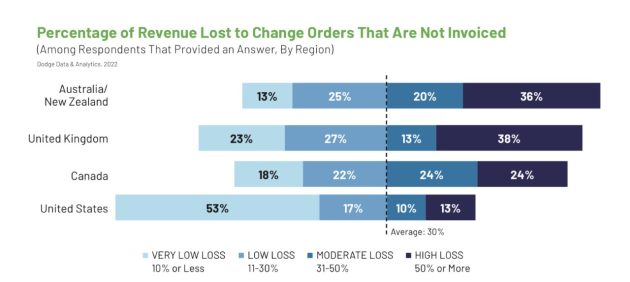
By Procore Technologies
Canadian subcontractors say that they faced an average of 39 percent revenue loss due to change orders that are not invoiced.
Canadian Contractor contractors home renovations subcontractorsIn partnership with Procore Technologies, Inc., Dodge Construction Network today released the results of its 2022 Top Business Issues for Specialty Contractors Report. This report highlights key issues impacting specialty contractors, including workforce management, technology and profitability to help businesses better understand recurring trends while broadening industry awareness of the advantages that can be created by leveraging digital solutions.
This global research was completed by five types of specialty contractors: mechanical, electrical, plumbing, steel and concrete. Key findings include:
Labour Shortage and Supply Chain Will Continue to Afflict the Industry
Research found that over 90 per cent of specialty contractors report their projects have been negatively affected by a shortage of skilled labour. Experts anticipate the current shortage to worsen: on average, 33 per cent of the current workforce is likely to retire in the next five years.
 The labour shortage, alongside supply chain disruptions, is having a significant impact on the industry. About one third of specialty contractors (31 per cent) cannot pass materials cost increases on to owners on half or more of their projects. This is highest among steel contractors (43 per cent), who face a very volatile cost market. Specialty contractors identify poor resource management (ie: labour, materials, equipment) and poor client communication as top drivers of rework.
The labour shortage, alongside supply chain disruptions, is having a significant impact on the industry. About one third of specialty contractors (31 per cent) cannot pass materials cost increases on to owners on half or more of their projects. This is highest among steel contractors (43 per cent), who face a very volatile cost market. Specialty contractors identify poor resource management (ie: labour, materials, equipment) and poor client communication as top drivers of rework.
To counter the negative impact of labour shortages, specialty contractors most frequently cite construction technology investments to improve productivity.
Rework is Significantly Impacting Profit Margins
Poor resource management often drives unplanned rework, which is a key drain on productivity, schedule management and cost control. In addition to that, unbillable change orders represent major lost revenue, especially for larger companies. On average, 30 per cent of project revenue is lost because of unbilled and unpaid change orders, according to survey respondents.
Leveraging Construction Technology Can Help Alleviate Some of the Industry’s Most Pressing Challenges
On average, specialty contractors report that 20 per cent of workers’ time is currently spent on low-productivity tasks, such as tracking down information or documenting information on paper. According to the report, an average of 39 per cent of respondents state they still primarily use whiteboards, spreadsheets and other outdated processes. This lack of standardized processes hurts field-to-office communication, negatively impacting the effectiveness of key project processes.
“The challenges specialty contractors are faced with today highlight the need for a connected platform built to address their needs,” said Will Lehrmann, head of product, specialty contractors, at Procore. “Several key takeaways show that the power of technology can help improve productivity and efficiency—as well as combat the workforce and skill shortages—that many specialty contractors are still facing.”
In order for contractors to advance and evolve to meet the needs of their clients, the report suggests company leaders must identify where inefficiencies are present within their organizations and adopt more dynamic technological solutions to address them.
Best practices for technology evaluation and implementation include:
- Identifying needs before evaluating options
- A phased roll-out plan
- A structured process for engaging key stakeholders
- Metrics to determine success
“Specialty trade contractors are vitally important to the construction industry,” says Steve Jones, senior director of industry insights research for Dodge Construction Network. “Dodge and Procore partnered on this research so these companies can better understand how their peers are performing and what could improve their critical outcomes. We sincerely hope these insights will help them operate more safely, efficiently and profitably.”
To learn more, download the report here.

Leave a Reply